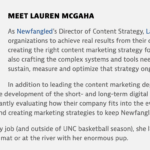The definition of a content strategy is “a plan for regularly adding unique, expert, and indexable content to your site.” There are many types of content strategies, but in this book I outline a website-based marketing content strategy. This sort of content usually takes the form of blogs, newsletters, white papers, webinars, videos, and podcasts. This is a detailed and intentional definition, so I will break it down part by part.
A Plan for Regularly Adding…
Whenever I discuss content strategy with agencies, one of the first questions that comes up is, “What does adding content to my site on a regular basis really mean?” The answer to this depends on which content strategy platform(s) you choose because different platforms come with different standard expectations for frequency of publication. Later in this section, I review the most popular content strategy platforms (newsletters, blogs, and webinars) and the frequency of publishing associated with each. In general, though, it is a good rule of thumb to plan to add at least two thousand words of content to your site each month (firm-wide), possibly broken up over the span of two to four articles. As long as the quality remains high, more is better, but a two thousand word per month benchmark is a sufficient starting point.
Depending on your experience, this may or may not sound like much writing to you. If you already have the knowledge that comes with specialization, it should not take any more than ten to fifteen hours each month to write, publish, and distribute two thousand words of copy. This time will obviously increase in proportion to the amount of research you need to do for each article. It is not a bad idea to mix things up, writing some articles based on your core knowledge and others that require more outside observation and research. Different people inside your firm may be drawn to different styles of writing in this way, which brings us to an important point.
Since one of the main goals of your content strategy is to reflect the expertise of the firm, it makes sense that multiple people inside of the firm contribute to it on a regular basis. This gives your prospects a more well-rounded understanding of the firm and offers a greater level of transparency and insight into your culture and what it might be like to work with you.
A Plan for Regularly Adding Unique, Expert…
The content you add should be written by your firm, based on your detailed expertise, as an educational resource for your prospects. Your site ought to be a wealth of information for the audience you serve. Do you know that feeling you get when you search on Google for something, and you finally find that site that not only answers the immediate question you asked, but so many other questions you had over the years as well? That is how you want your prospects to feel when they find your site.
Through your content strategy you should describe your firm’s expertise as clearly and openly as possible. You want to be generous with the knowledge you share through your site’s content strategy. This idea makes many agencies feel uncomfortable in two ways.
First, they worry that if they give away too much on their site, their clients will no longer need to hire them. We have found this to be absolutely untrue. One reason for this is that although you share your knowledge in your content strategy, you are not applying that knowledge to specific client problems. This allows you to demonstrate your intelligence without obviating the need for your clients to hire you. The other thing that happens when you describe your expertise in detail is that your prospects realize just how complicated the situation really is; they realize that there is a lot more to a perfect marketing solution than just a new coat of paint.
Second, agencies worry that if they put too much of their knowledge on their site, their competitors will steal their ideas. This one is partially true. The term “thought leader” implies that there are followers. Who would you rather be, the leader or the follower? When you are a leader, the followers are usually your competition. While it is possible that your competitors may borrow a few ideas from your site now and then, the value of the impression your site makes on your prospects far outweighs the danger of someone stealing a particular nugget of thought. Mimicry, to a certain extent, is the price a thought leader pays for being at the forefront of their industry. Most well-educated prospects can tell the original from the fake, especially once they speak to both firms. If the prospect is aware enough to realize that Agency B is borrowing your content, your position gets elevated even higher. That being said, I have not seen this scenario happen very often. The agency world is a small one, even more so for specialized agencies, and few agencies are shameless enough to steal content and publish it in a format as public as a website.
A Plan for Regularly Adding Unique, Expert, and Indexable Content…
Indexable means that search engines can easily discover and read the content. In order to do so, the content cannot be hidden inside an image, a Flash movie, a PDF file, or behind a login. The content, in full, needs to be right there on the page for the world to see. Not putting your content in Flash or images is easy enough for most agencies these days, but the other two obstructions usually raise a few questions.
Having your content in a PDF file is great, as long as the entirety of the content is also on the web page. Some of your visitors may be more likely to download a PDF, possibly print it, and read it on their own time rather than reading the content through a browser on your site. I am all for allowing people to consume your content on their terms. You just want to make sure that any content that is in a PDF is also presented on your site to visitors and search engines alike in an indexable format. A quick trick you can use to tell if your content is indexable is to start at the top of a paragraph, click, and then drag your mouse to the end of that paragraph. If the text highlights, it is indexable.
The more common objection I hear has to do with putting content behind a login. If your site visitors cannot read your content without logging in or submitting some sort of form, that means Google cannot see it either. Many agencies (and businesses in general) want their visitors to log in to access content so that they can see who is reading what and to gather lead information. If your site already receives all the traffic you could ever want, this might be a good way to go (maybe). Most small agency sites, however, average well below one hundred unique visitors per day and, therefore, are not receiving enough traffic to afford the freedom to take this approach. There is a truth of people’s online user behavior that makes this point moot, anyway.
If your visitors find your content engaging enough that they are willing to take the time to fill out a form, they are more likely to do so for the convenience of automatically receiving your content (e.g. Subscribe to Our Newsletter) than they would be to have the privilege of reading your content in the first place (e.g. Log In to Read the Article). A site that publishes all of its content for the world to read and for search engines to index, unencumbered, will bring in far more traffic and capture far more total leads than a site that hides everything behind a login. The golden rule here is to be generous with your content strategy.
A plan for regularly adding unique, expert, and indexable content to your site.
This point mostly pertains to blogs. Many agency blogs exist outside of their site. This usually happens because the agency did not consider including a blog on their site during their last redesign, and it is so darn easy and cheap to install a blog, set it up under blog. agencywebsite.com, and make it look sort of like the main site. The blog is literally tacked on to the site. Since many people do it, it may seem that this practice is just fine. It’s not.
So many agencies’ blogging strategies go awry when they put the blog—and all that great blog content—on a separate site. This is a problem for two distinct and important reasons. The first is that you want your prospects on your site, period. You want them to be able to land on a blog post via a Google search, discover that you are smart and worth examining, and then jump easily right into your portfolio, sign up for your newsletter, contact one of the principals, or forward the post to a friend—all within one click from the page on which they initially landed. If the blog is on one site, and all or some of those things are on another site, you miss the main benefit of any work you do on the blog.
Agencies sometimes think they solve this problem by putting prominent links back and forth from their main site to their blog site. A quick look at your analytics account will show you that most people do not go from your blog back to your main site.
The second reason that separating the two sites is a problem has to do with search engine optimization. While Google is smart enough to understand that blog.agency.com is related to agency.com, nothing beats having all of your content under one single domain. This argument, coupled with the first argument, leaves us with few reasons to keep the sites separate. In fact, when it comes to content strategy for marketing firms, I cannot think of a single one.
This post is an excerpt from my book, “A Website That Works.”
#macro:blognav,24160,24164#


